Six notebooks compared: Leuchtturm1917, Rhodia, Midori, MUJI, Northbooks and Moleskine [updated]
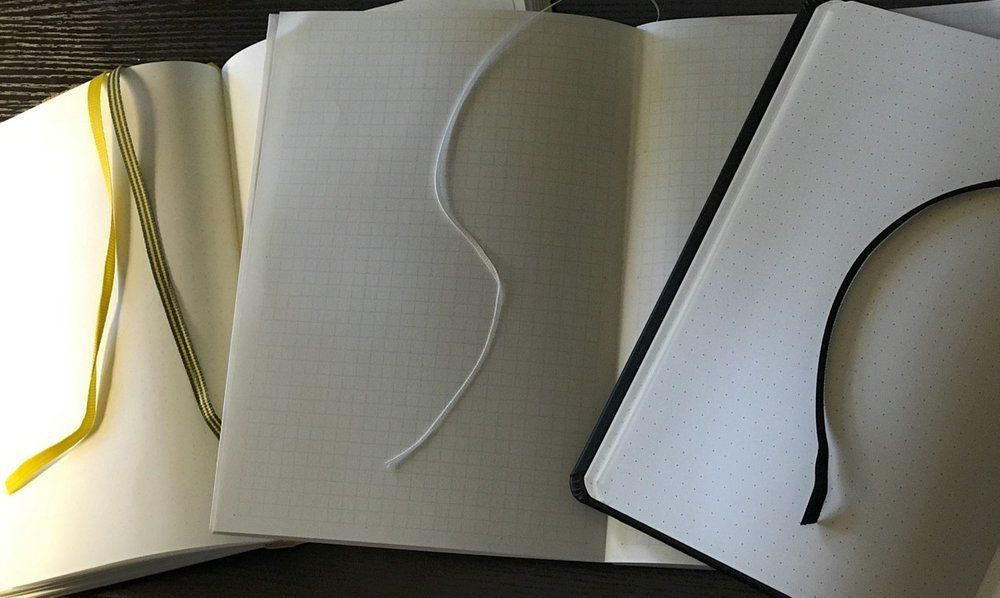
A while ago, I got interested in bullet journaling. Eager to get going on it quickly and discover how I would use this freeform style of journaling and personal planning, I initially went with the popular bujo favorite, the Leuchtturm1917.
But I was immediately frustrated when I saw how much ghosting I had on the reverse sides of my pages. I needed to find the best bujo notebook.
Bullet journaling, at least in my mind, demands a higher standard. Since I’m using the bujo for writing ideas, brainstorming, to-do list planning, and journaling, I refer back to my entries frequently, often marking them up or highlighting passages. I expect when I’m done with it, my bujo will become an archive of my thoughts and challenges of the period. All this demands a minimum level of quality paper. And the Leuchtturm1917 wasn’t doing it for me.
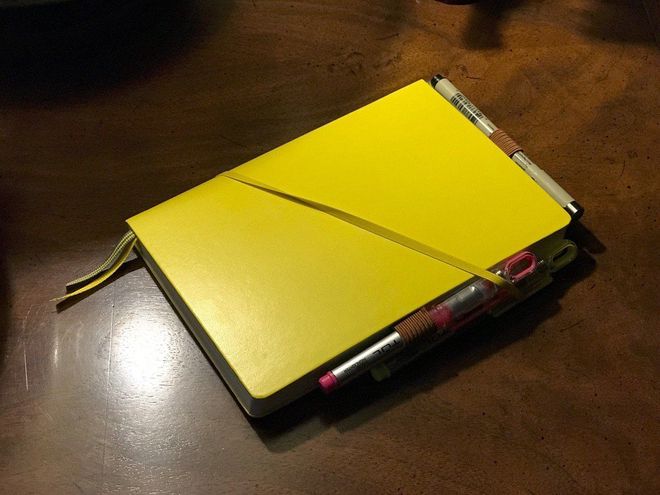
I had to do some research and figure out just what brand of notebook I wanted to use for my bujo endeavors. So I went and geeked out on it. I love notebooks, papers, and pens. I’ve always had periodic favorites of each, but this was the first time I sat down and did a side-by-side comparison between notebooks and their papers and how they worked with a variety of pens.
What is the best bullet journal notebook? This is a quick(ish) rundown of my findings.
I compared six different notebook brands:
- Leuchtturm1917 medium sized, dot grid, 125 sheets (249 numbered pages), hardcover
- Rhodia Black Webnotebook 5.5 inch x 8.3 inch, dot grid, 96 sheets, hardcover
- Midori MD Notebook, A5 Grid Paper, stitched softcover
- MUJI Thread Binding Notebook A5 Dot-grid, 96 sheets, stitched softcover
- Northbooks 5x8 Notebook, Dot Grid, 96 Perforated Pages, stitched softcover
- Moleskine Cahier Journal, Large 5 x 8.25 inch, Ruled, stitched softcover
For each, I evaluated:
- Cover and binding
- Paper quality
- Bleed-through and ghosting results
- Overall assessment
In particular, I compared various pens on the paper for marking ease and bleed-through. I also put each notebook through the basic break-in process demonstrated in this video by designer Ryder Carroll, who kind of started the bullet journal methodology and has become the starting place for anyone looking to get into bullet journaling.
I used a variety of pens for the testing:
- MICRON 03 0.35 (felt)
- PILOT V Razor Point Extra Fine (felt) in various colors
- TUL Needle Point 0.5mm Fine (ball)
- TUL Medium (ball)
- TUL Fine (felt)
- PILOT G-2 05 (ball)
- FORAY Stylemark Fine 0.5mm (felt)
- BIC GripRoller Fine (ball)
- MICRO-LINE (felt) in .25mm, .35mm, and .5mm
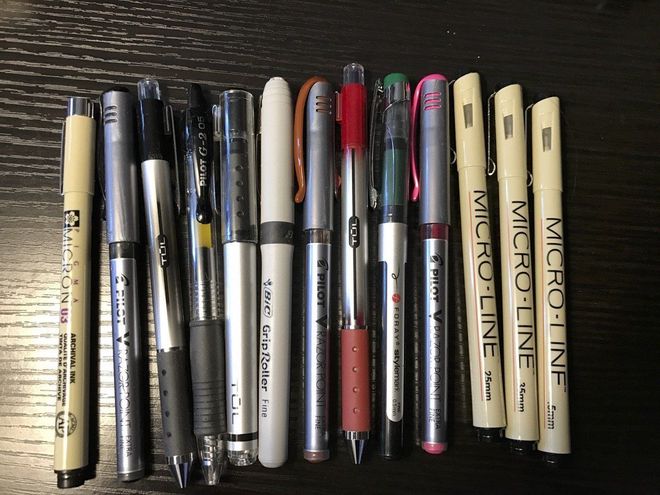
I also used a few highlighters:
- TUL Chisel Point Desktop Highlighters in various colors
- TUL Liquid Highlighters in various colors
- DENNISON Fluorescent highlighter
- FORAY highlighter
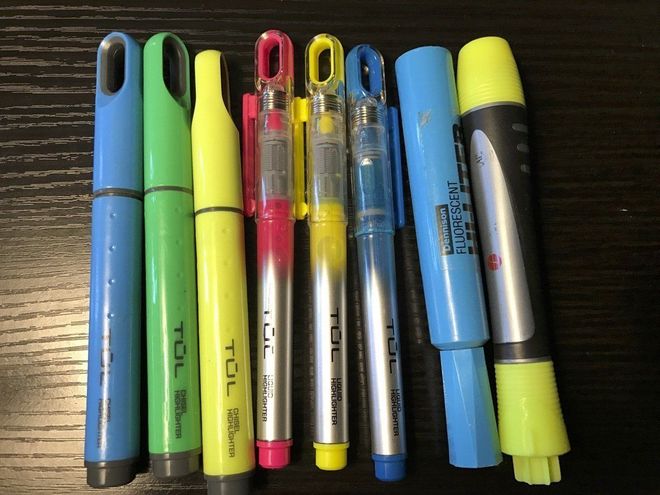
With each notebook, I compared various pens on the paper for marking ease and bleed-through. I also put each notebook through the basic break-in process demonstrated in this video by designer Ryder Carroll, who kind of started the bullet journal methodology and has become the starting place for anyone looking to get into bullet journaling.
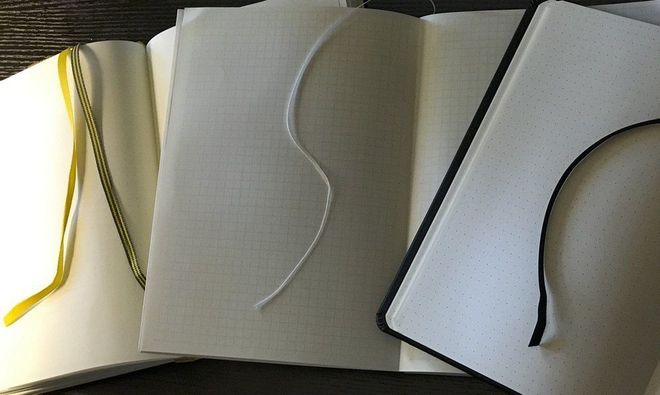
Here are the reviews of the notebooks.
1. Leuchtturm1917 medium sized, dot grid, 125 sheets (249 numbered pages), hardcover
The Leurchtturm1917 notebook is a popular favorite among bullet journalists. I was quite impressed with the overall quality of the construction, especially the binding. Two distinctive ribbons are available for marking places. This notebook also has preprinted headings for an Index and page numbers discreetly printed in the corners. None of the other notebooks reviewed here include these conveniences.
Cover and binding
The binding lies flat very easily and does not give any impression that it might pull apart. The casing is firm with a nice durable hardcover. The one I got was a nice yellow hue. (Leuchtturm seems to have the greatest color selection of any notebook.) The cover has a sealed surfacing to it, so it doesn’t seem to be easily dirtied—important especially if you’re handing it with possibly inky fingers. There’s a pocket inside the back cover for holding small notes. I use it to hold a small ruler and the labels that came with the notebook. It also has an elastic closure strap.
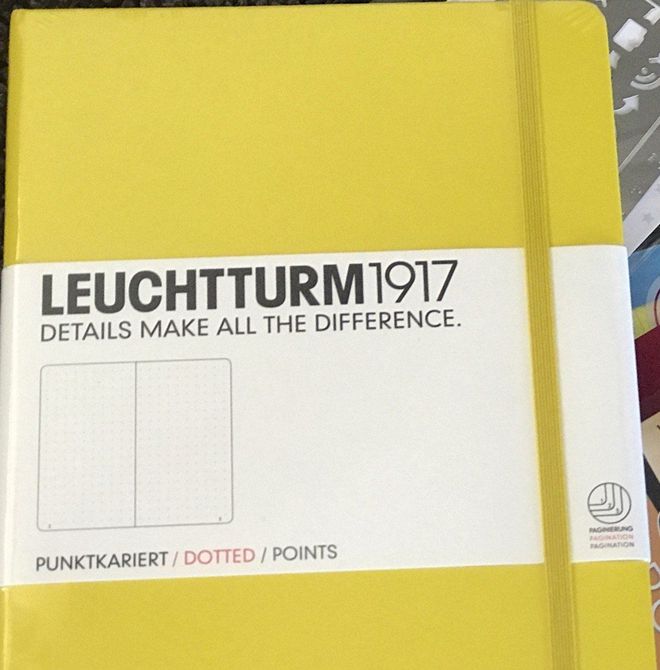
The Leuchtturm1917 cover with packaging wrap label.
Paper quality
The paper itself is a bit rough. Not terribly so, but it is noticeable, especially as compared with the Rhodia and MUJI notebooks. The roughness of the paper means makes for a different kind of pen point flow across the page. Once you get used to it, it’s fine. I wouldn’t call this a problem. But it’s worth noting how it does feel different from some of the other notebook papers.
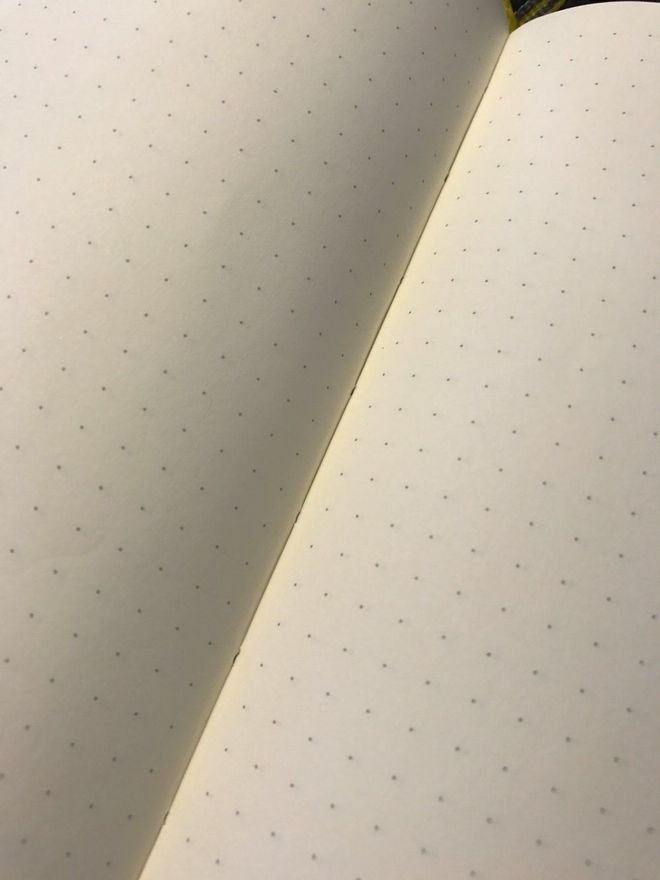

The dots are rather faint. While actually putting pen to paper, I found the faint dots to be only slightly helpful for guidance. The outer corners are rounded.
Bleed-through and ghosting results
As for ghosting, I have to say, I’m fairly disappointed with the visibility of writing on the reverse side of the sheet. Every pen demonstrated significant ghosting on the reverse.
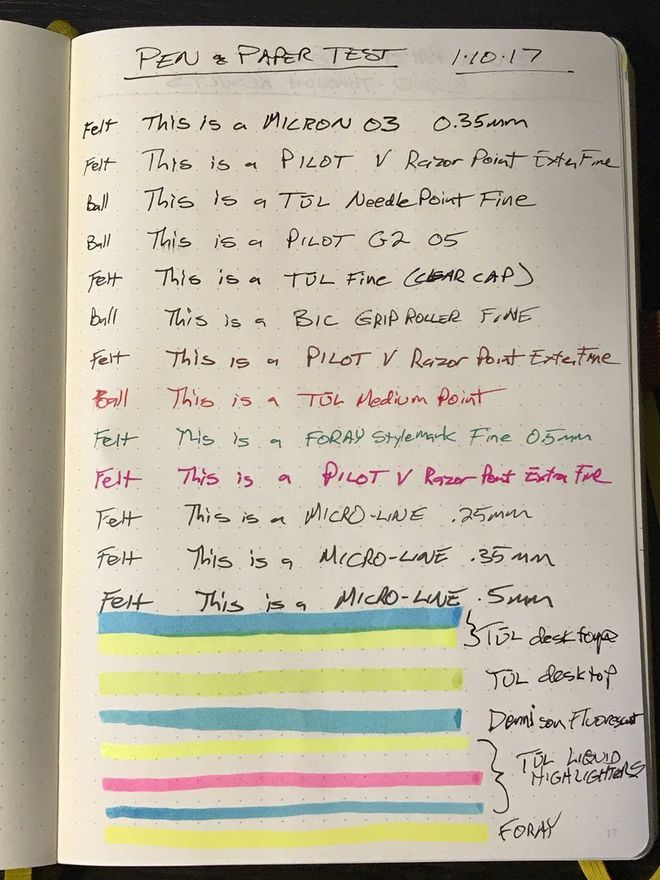

Some of the Pilot V Razor Point pens actually bled through or threatened to (which is a shame, because I love these pens).
Overall
If binding is your number-one criterion for notebook selection, the Leuchtturm1917 might be the one. But if paper quality is a big bugaboo for you, you might look to one of the others.
2. Rhodia Webnotebook 5.5 inch x 8.3 inch, dot grid, 96 sheets, hardcover
The Rhodia has turned out to be my favorite notebook so far. I’ve always liked the Rhodia line of notepads and used various ones in the past. This was my first Rhodia bound notebook. The construction quality is excellent. Inside the back cover is a pocket much like the Leuchtturm1917.
Cover and binding
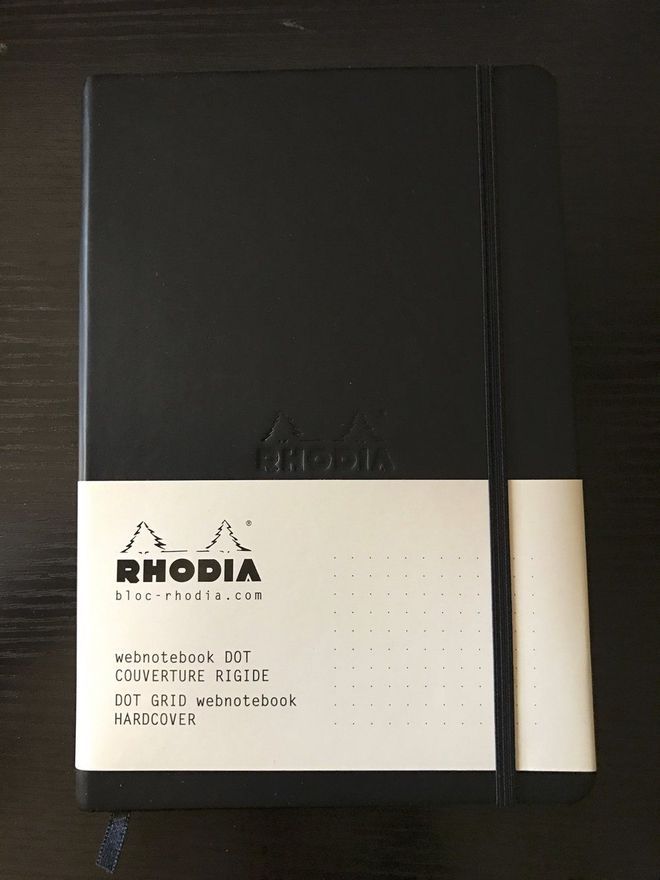
The Rhodia Webnotebook has a pleasant leather-like hardcover.
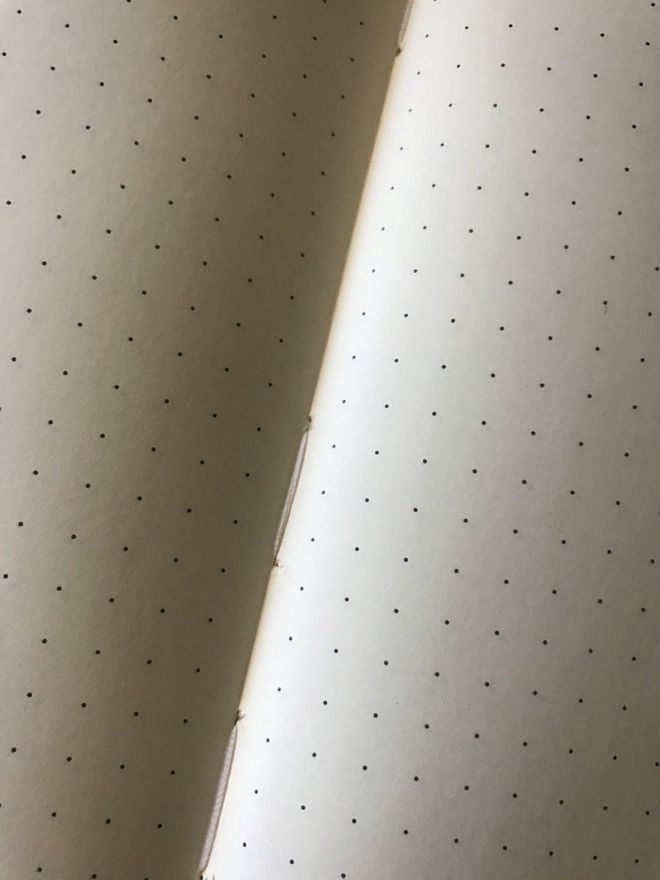
The binding quality is excellent. However, the notebook I received took a bit more attentive breaking-in to get it to lay flat on every spread, but lay flat it does. There seems to be no danger of the binding coming apart. The cover is a smooth black with a kind of leather feel. One black ribbon is attached for marking your place. It also has an elastic closure strap.
Paper quality
The paper of the Rhodia notebook (Ivory, 90 gsm) is my favorite of all those compared. It’s quite smooth, much smoother than the Leuchtturm1917. Only the MUJI paper comes close. The smooth paper allows for a very nice grid of both felt tips and ball points, but without beading of ink on top of the surface. This makes for a delightful marking experience.
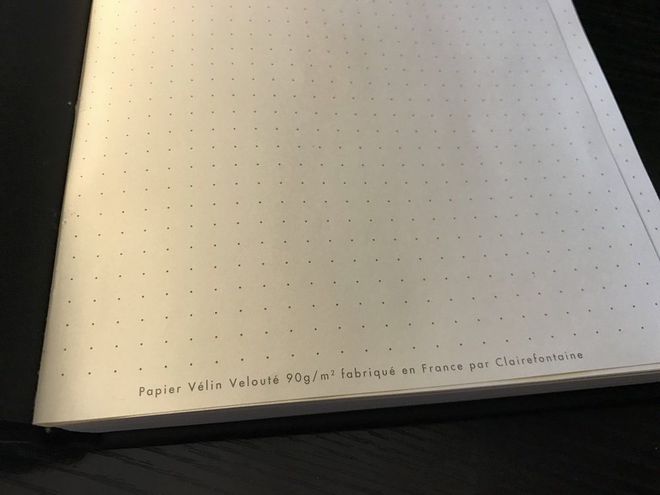
The dots are considerably darker, which I actually like; the greater visibility makes them more useful.
The outer corners are rounded.
Bleed-through and ghosting results
Very impressively, none of the pens created any significant ghosting at all on the reverse side of the sheet. The photos below pretty much say it all.
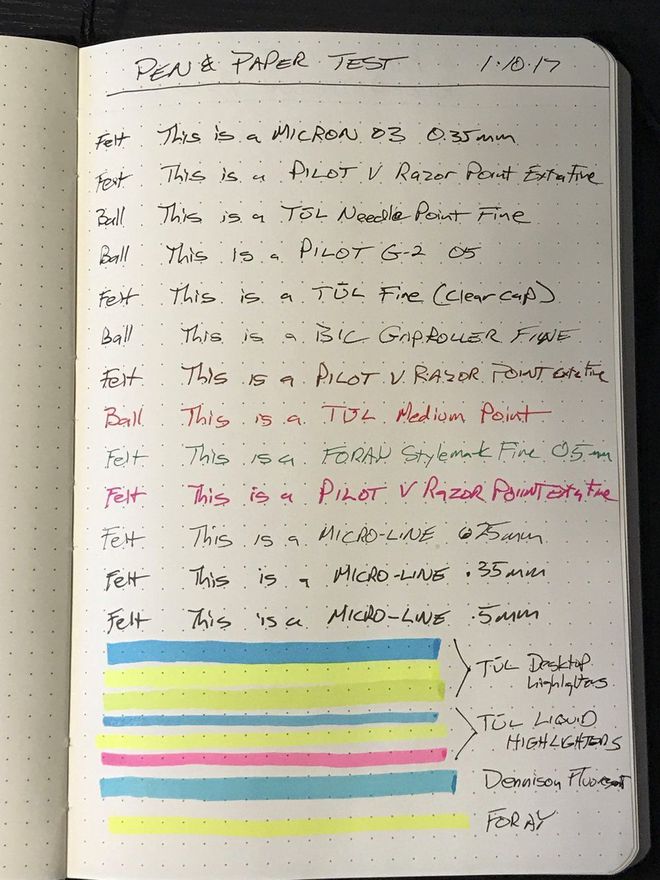
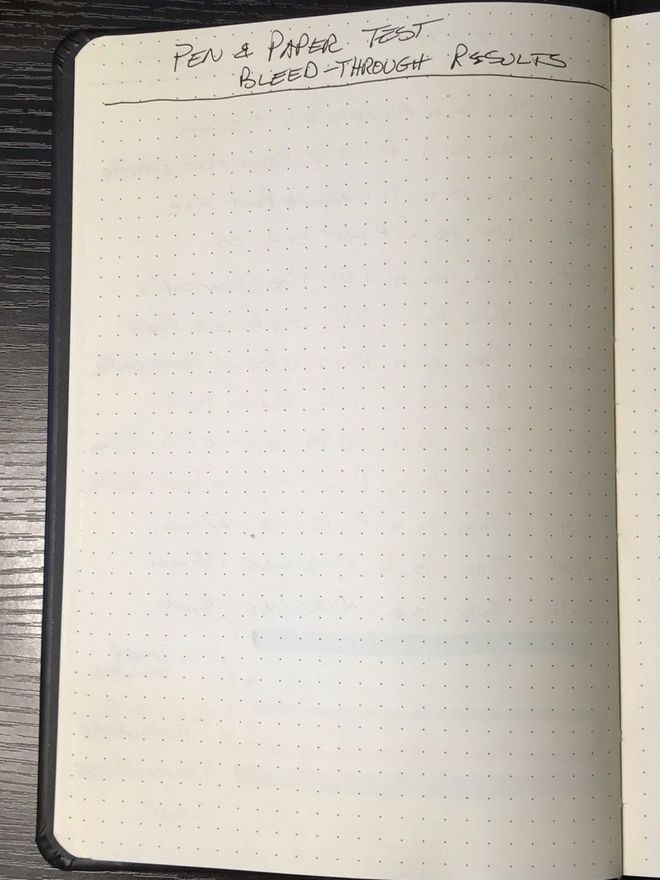
Overall
The binding is excellent, though a bit tighter than the Leuchtturm1917, so it took a bit more breaking in to lay flat in open spreads. The paper is the best of all the notebooks tested, with a beautifully smooth feel and little or no ghosting with pens I tested. This is my favorite.
3. Midori MD Notebook, A5 Grid Paper, stitched softcover
The Midori comes highly recommended from Japan, where it is made and apparently is a (or the) popular choice for students. Upon first impression, it doesn’t seem like much. It’s when you look closely you notice the wax-paper cover, the quality paper, the easy-to-miss silver-white ribbon, and the stitching in the glued binding.
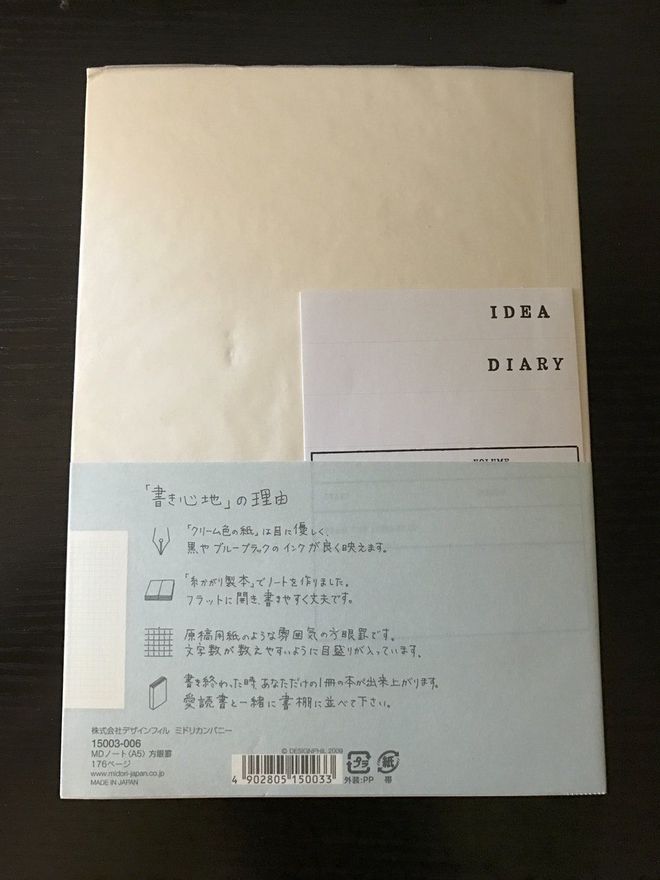
The Midori MD notebook stood out as unique among all those tested (and in general, in my experience).
Cover and binding
The outermost pages of the notebook are a kind of card stock and serve as a soft cover. The lightweight wax-paper covering wrapped around the outside looks odd at first. I’m not sure why they chose to include what seems like a fragile cover. I’m not sure I would keep it except maybe to cover once done with the notebook.
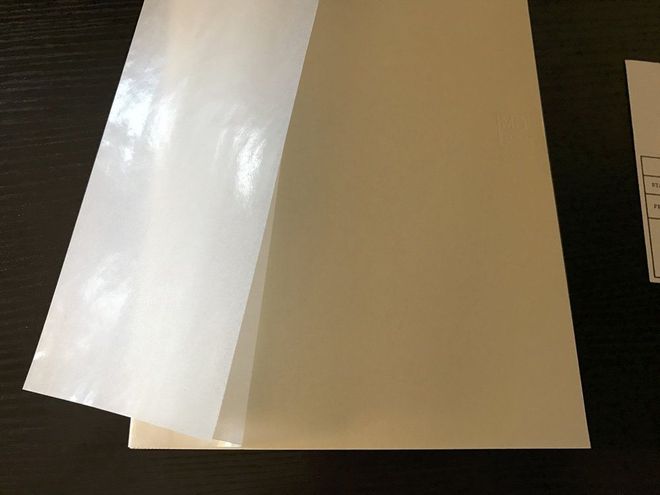

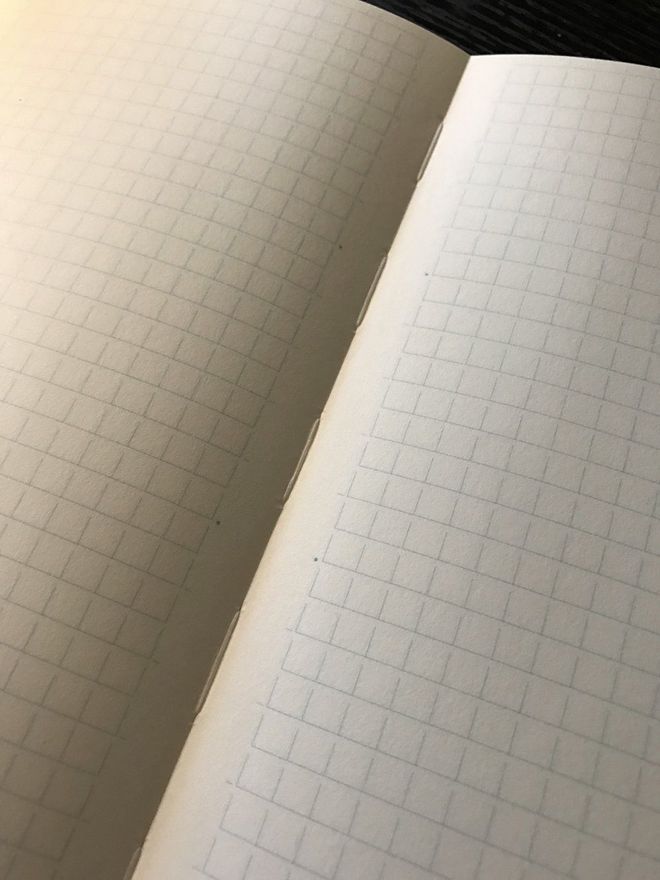
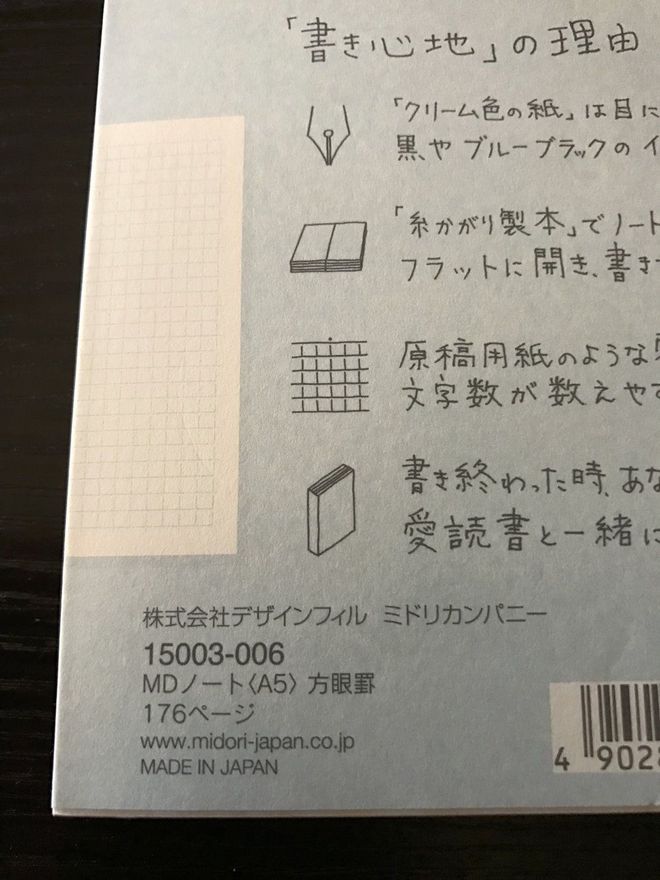
As you can see in the photos, the binding is indeed stitched quite well. A waxed cheesecloth binding cover wraps the binding and cover edges. What you don’t expect is the silver-white ribbon that you can use to mark your place—not a typical softcover feature.
Paper quality
The Midori’s paper feel is a bit smoother than the Leuchtturm but less so than the Rhodia and MUJI. I could not find any information on the paper weight (not even on the Midori website). By feel it seems to be about the same or a tad heavier than the Leuchtturm1917’s paper.

The grid lines are faint and actually do not meet 4-way, giving it a kind of open feel that does not impose like most graph paper. I enjoyed writing on this paper.
The corners are square.
Bleed-through and ghosting results
The Midori paper performed better than the Leuchtturm1917 at preventing bleed-through. However, there was just as much ghosting. I couldn’t say whether the darker grid makes the ghosting more or less noticeable.
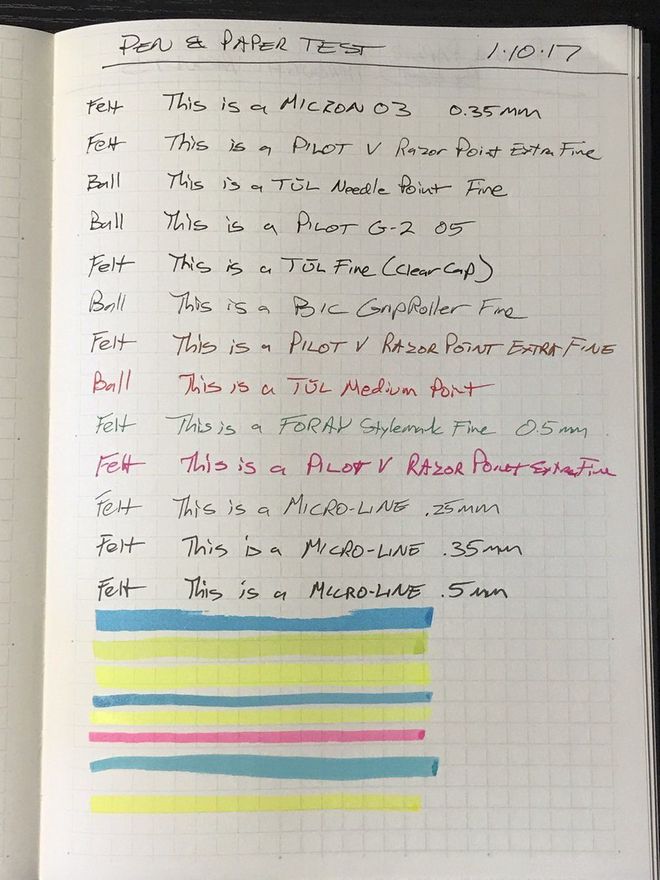
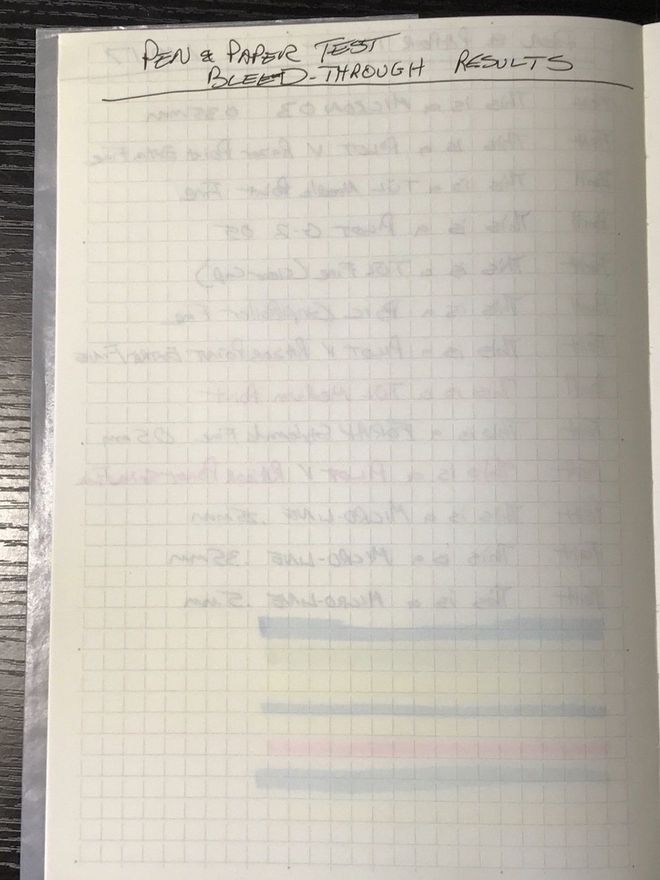
Overall
This is actually quite a nice notebook that I can see myself using quite a bit. Perhaps if I found the right durable and attractive A5 cover, I could find added appeal of using these “coverless” notebooks. The ghosting is more than I care for, however.
4. MUJI Thread Binding Notebook A5 Dot-grid, 96 sheets, stitched softcover
The MUJI notebook is much like the Midori, with a cardstock cover. It is also made in Japan.
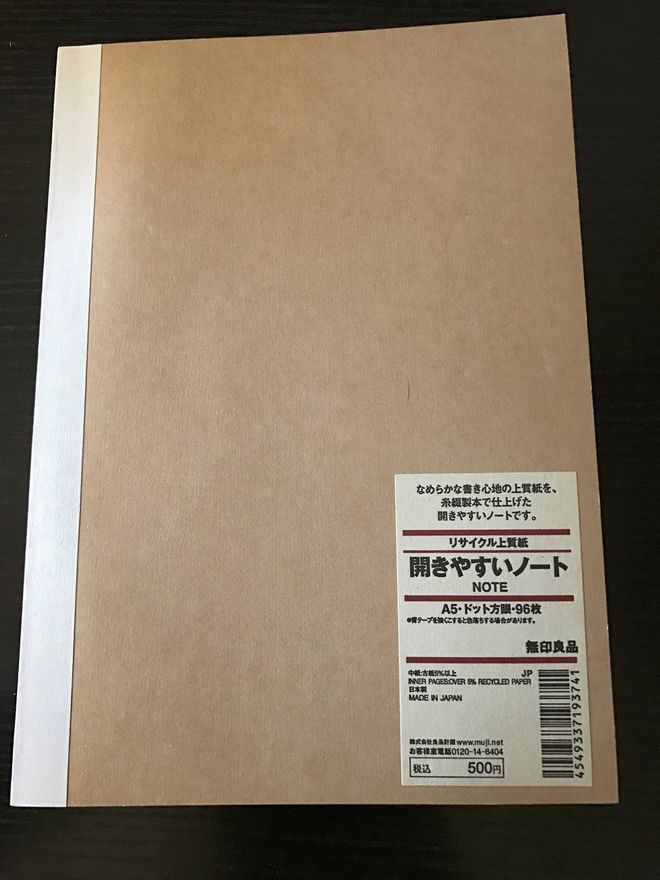
The MUJI notebook has an unassuming appearance.

Cover and binding
The MUJI notebook has a feel and binding similar to that of the Midori. The stitched binding is wrapped with a robust tape.
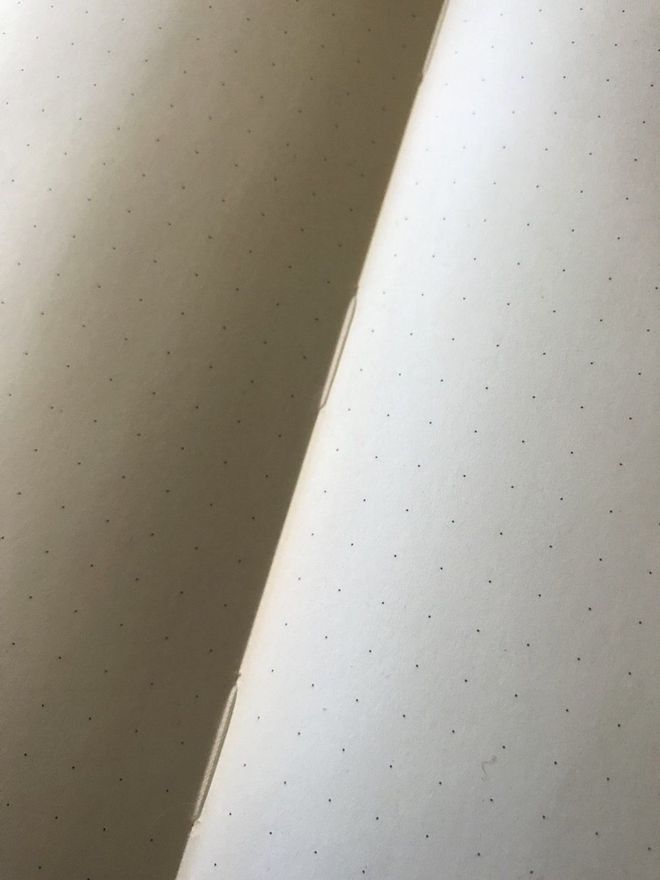
Paper quality
I was unable to find information about the paper weight, but it is lighter than the Rhodia and Midori paper. A cover label indicates that the interior is more than 5% recycled paper). The feel is very smooth, much like the Rhodia, though the color is whiter. This gives it a wonderful feel while writing.
The grid is very faint, a touch lighter than with the Leuchtturm1917.
The corners are square.
Bleed-through and ghosting results
Writing on the smooth paper feels quite pleasant. There was some ghosting on the other side. A couple of the highlighters bled through, though this could have been due to variations in penning the marks. Even so, this was considerably less ghosting than on the Leuchtturm1917.
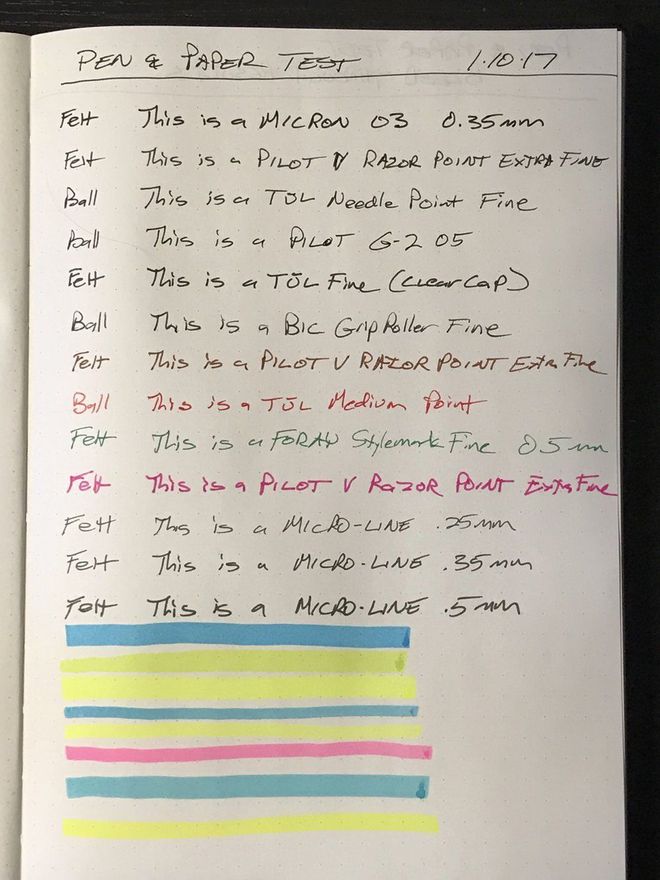
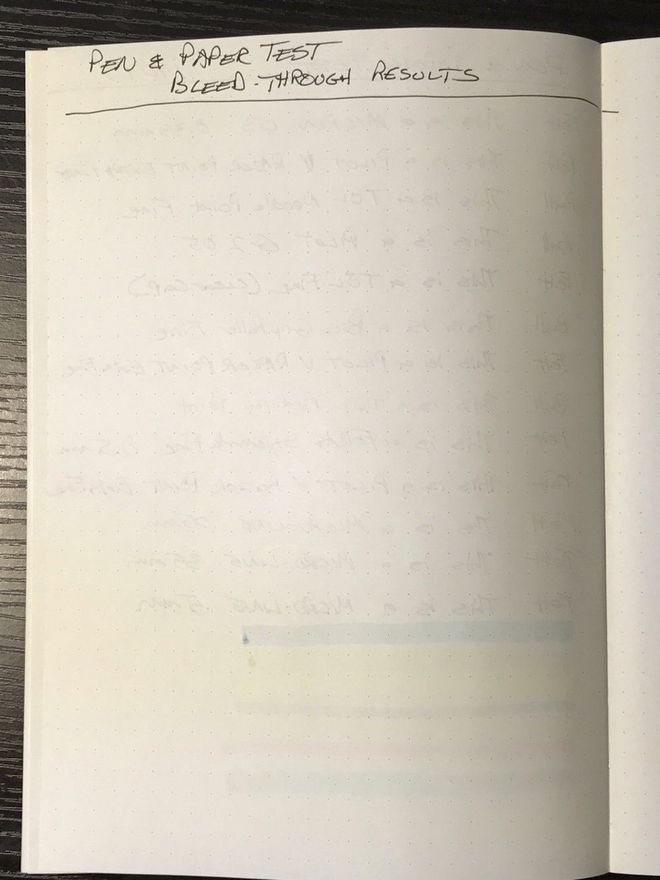
Overall
I prefer this MUJI over the Midori mainly for the quality of the paper in terms of smoothness and less ghosting. The bleed-through of the TŪL Chisel Desktop Highlighters can be avoided by using their liquid highlighters. I am not bothered by the lack of a ribbon marker, but that may sway some buyers.
5. Northbooks 5x8 Notebook, Dot Grid, 96 Perforated Pages, stitched softcover
This notebook really is a different breed in that its pages are perforated for easy removal. There are 48 sheets to make 96 pages. The cover is 50% post-consumer recycled paper. It’s made in the USA.
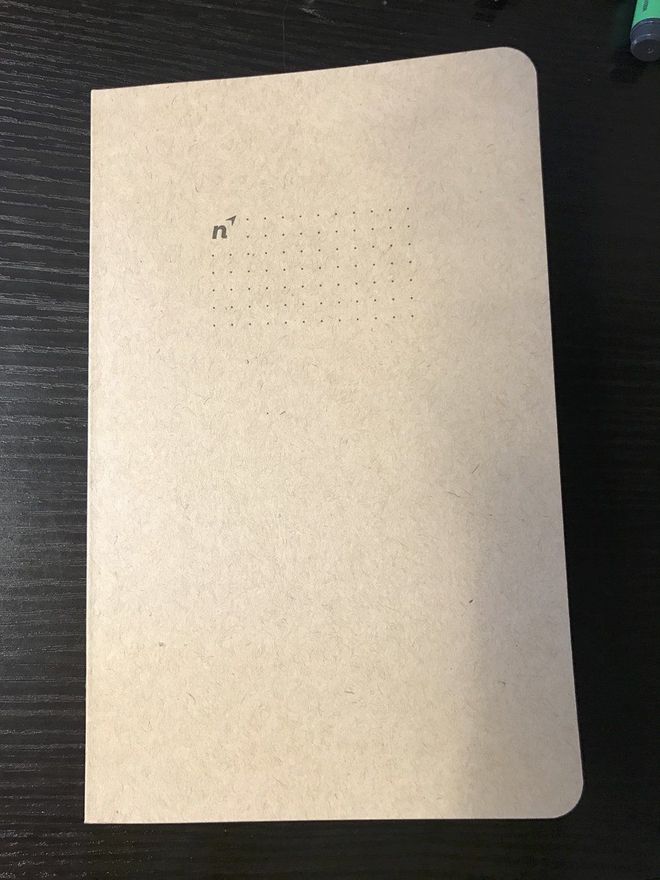
Cover and binding
The notebook is perfect-bound. When you try to flatten it, the pages articulate on the perforations rather than at the binding. This means that it’s really not a lay-flat kind of notebook.
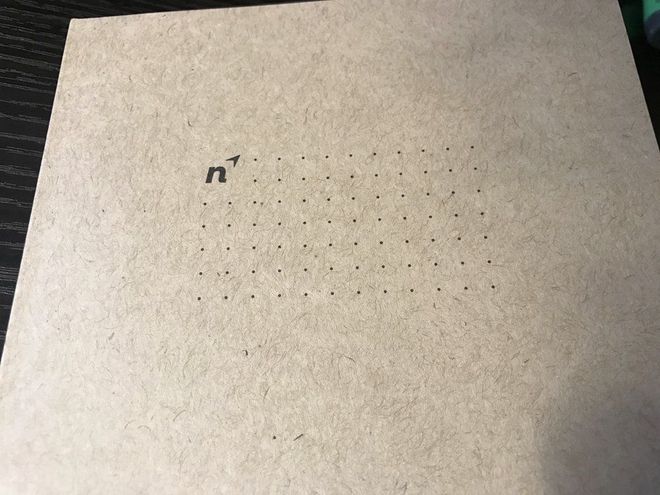
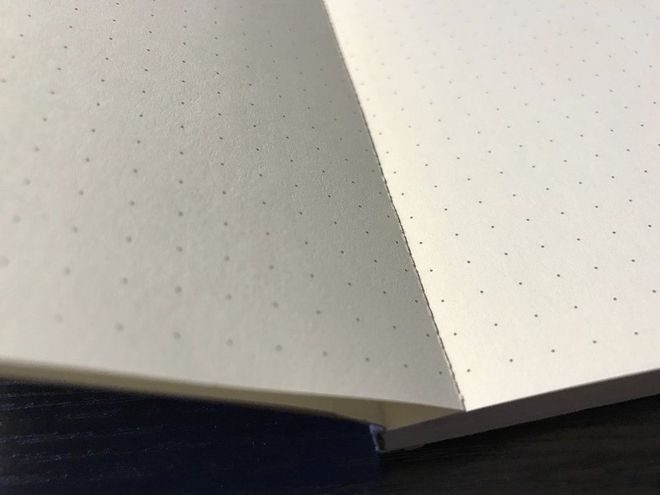
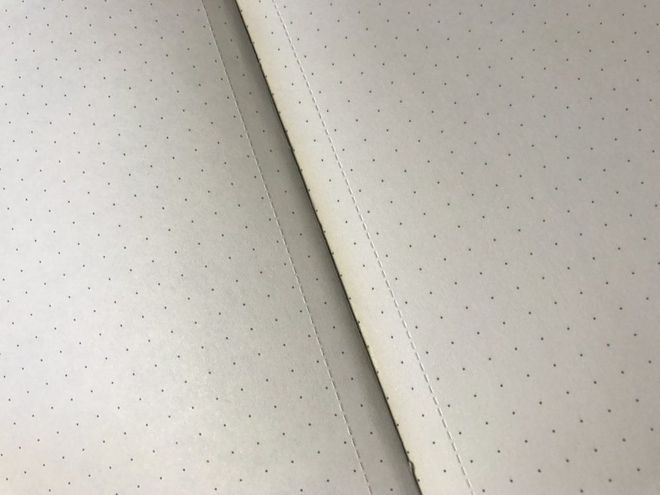
This notebook seems well suited for jotting things down and tearing them out to refer to elsewhere.
Paper quality
The paper is 60-lb, 89 GSM, with a rough feel much like the Leuchtturm1917. The feel of pen on paper is quite nice.
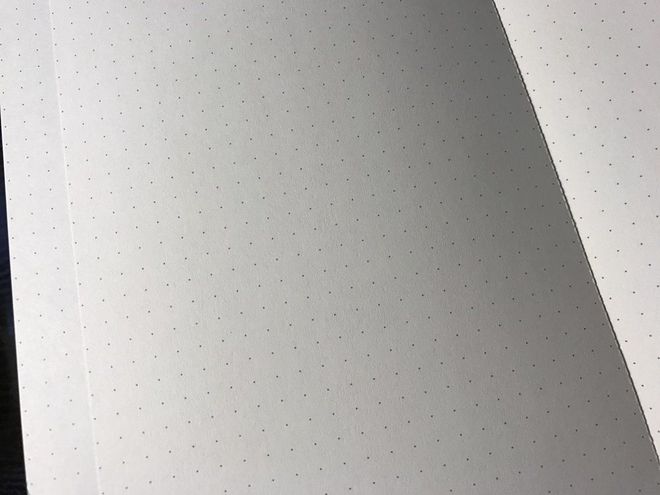
The gray dot grid is a bit darker than on the Leuchtturm. The outer corners are rounded.
Bleed-through and ghosting results
As this was not really an ideal notebook for bullet journaling, I did only an abbreviated pen test. However, the results were impressive, with the least ghosting of any of the notebooks with the exception of the Rhodia.
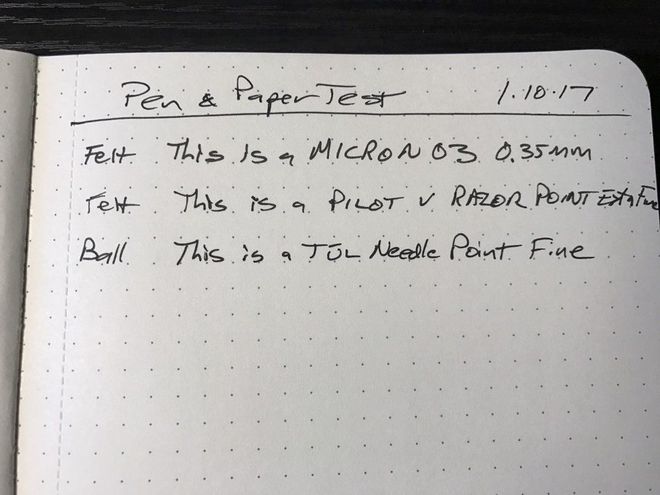
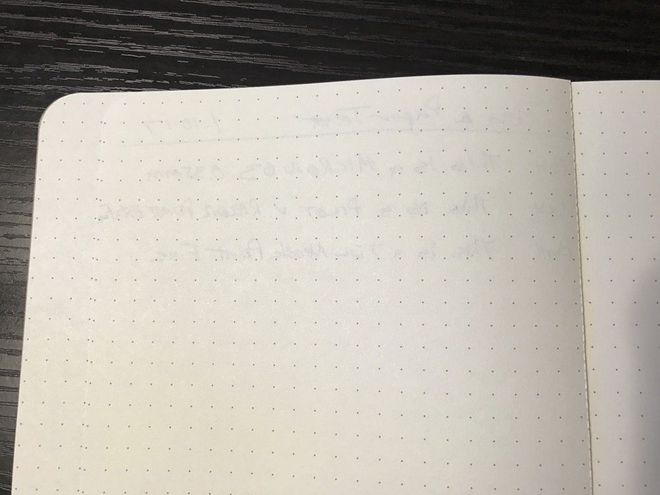
Quite impressive.
Overall
For carry-around notebooks, the Northbooks easily beats out my old favorite Moleskine notebooks. The inability to easily lay the notebook flat is less of an issue to me because the use case for this notebook is more of the quite note and less of a journaling/contemplation kind of task. The perforations are extremely convenient for this as well. This notebook is a nice discovery.
6. Moleskine Cahier Journal, Large 5 x 8.25 inch, Ruled, stitched softcover
I’ve been using Moleskine notebooks for a few years now for hasty note-taking. I like their trim, saddle-stitched construction and their otherwise clean appearance. I expected the Moleskine to fare well in this test. I was quite surprised what I found.
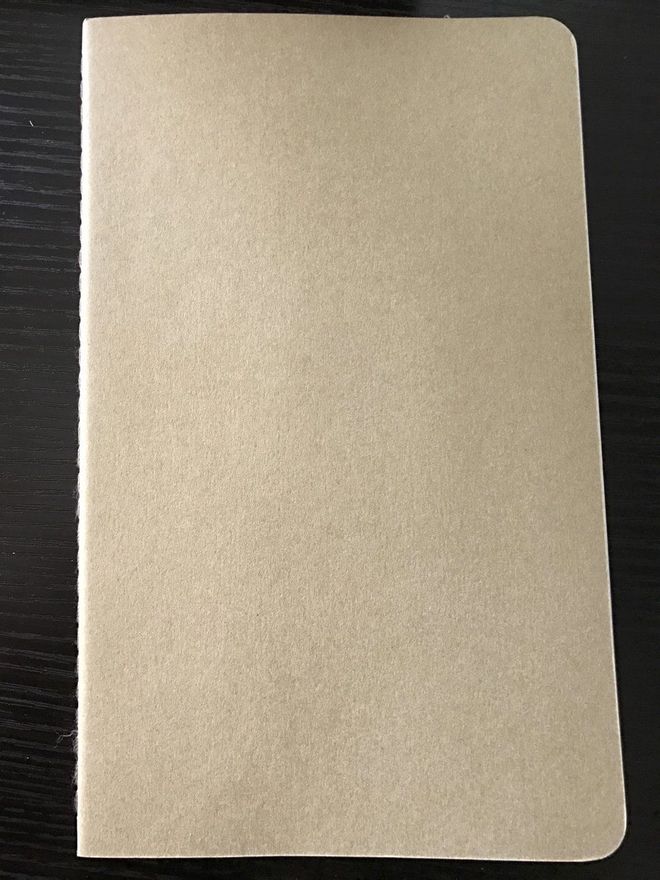
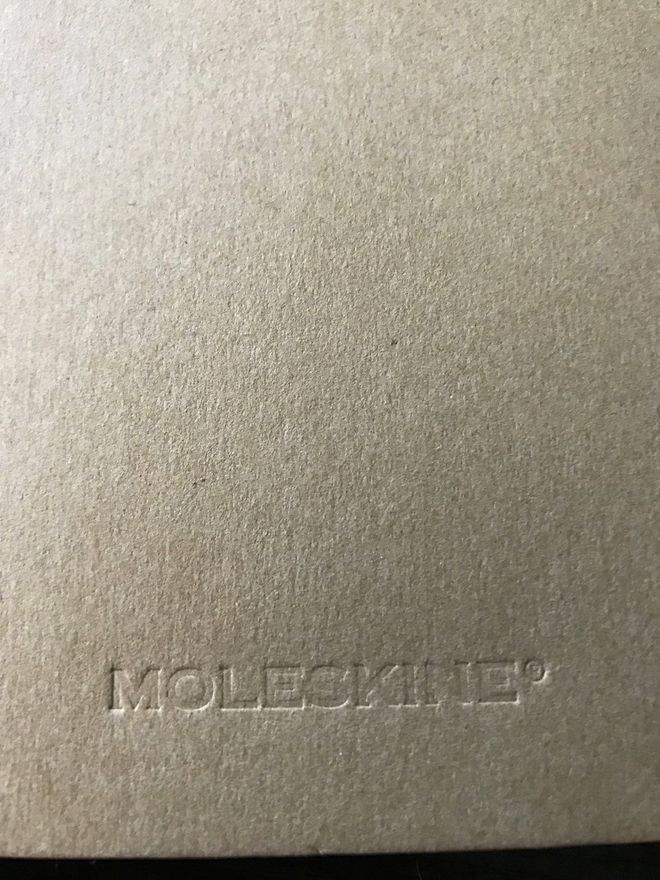
Cover and binding
The cover of the notebook I tested is a plain undyed brown. However, Moleskine does offer a wide variety of notebooks with coated, colorful covers. The very high quality saddle stitch binding contributes greatly to the quality feel.
The little flap in the back, though, almost seems useless. I’ve never ever put anything there because it’s not really a pocket and I’m not sure what tools I would want in a thin paperback journal.


Paper quality
The paper, on paper, seems to be a decent quality 70 gsm/47 lb. (FSC Certified, Acid-Free). The texture is slightly rough. The color is a light cream, more white than the Rhodia and Midori, not as white as the MUJI, Northbooks, and Leuchtturm1917 paper. My version has narrow rules that are not too dark—nice for keeping lines straight without becoming stifling or distracting. The last fifteen or so sheets are perforated for easy tear-out removal.
The outer corners are rounded.
Bleed-through and ghosting results
This is where the Moleskine kind of shocked me. The ghosting is quite noticeable. In the past, with some pens I’ve experienced bleed-through. Overall the paper seems to be quite porous.
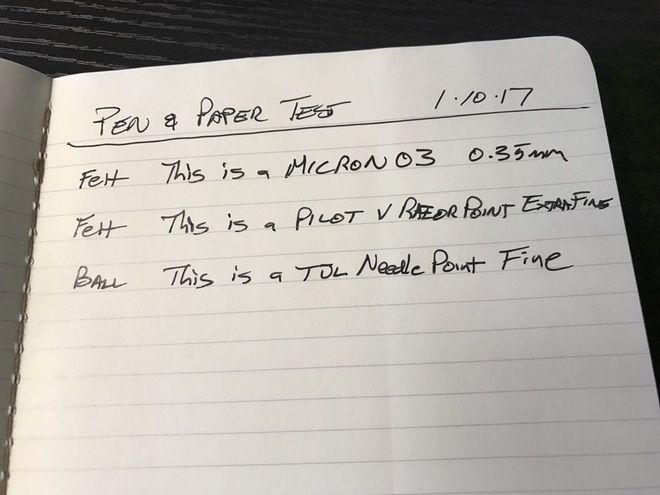
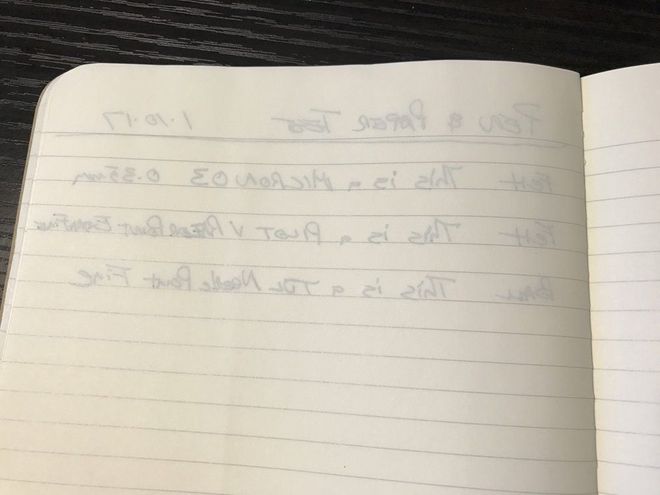
I thought this disappointing result might have been the result of a recent downgrading of the paper by Moleskine. However, my older notebooks from the past few years exhibit the same amount of ghosting. It just never bothered me before because I was just jotting down notes.
Overall
While Moleskine was my regular notebook of choice in the past, it no longer is. The quality stitching is top notch, but the ghosting problems of the paper are just a bit too much for me.
7. (bonus) Dingbats* hard cover notebook [added October 2018]
There’s a new kid on the block—actually a really really old kid, a printer in business since 1800, who has produced this notebook that gets me all kinds of excited:

The Dingbats* hardcover notebook comes in many colors, each with a different animal/setting—Black Duck, Blue Whale, Brown Bear, Green Deer, Lime Yasuni, Orange Tiger, Red Kangaroo, Sky Blue Gbr, Tangerine Serengeti. Some of these are offered with extra bujo feature. I love the other colors, but I chose gray for the elephant. Paper is available in dot grid, ruled, plain, and squared graph-style.
I actually bought this over six weeks ago, but I still have pages in my current notebook (one of the bujo notebooks in this review—can you guess?) I’m only now playing with the Dingbats*, but so far I love it. I will post a review soon.
/end update
Conclusions
This was an eye-opening experience, especially with the pen test. (I’m smacking my forehead, wondering why I didn’t regularly do pen tests before.) I’ve come away with two favorites:
Rhodia is the best bujo notebook
The Rhodia Webnotebook matches the Leuchtturm1917 in cover quality, comes extremely close in binding, and comes out the big winner in paper quality. You still get the ribbon marker. And if you really want more ribbons, use the ribbon-tying or ribbon gluing trick (Google it) to add more. And the rear pocket. And the elastic closure strap.
One of my projects over the next few days will be to migrate what bullet journaling I’ve already done from the Leuchtturm1917 to the Rhodia Webnotebook.
Northbooks notebooks are a quality find
I’m liking the Northbooks notebook for use as a portable notepad. The quality paper with minimal ghosting makes for a pleasant experience. In fact, only the Rhodia matched or outperformed the Northbooks in the pen test. (The Rhodia was more rigorously tested, so I hesitate to compare the two directly.)
The shocker for me is how much I much prefer the Northbooks quality to my old mainstay, Moleskine. I could see myself carrying this notebook in my purse for making little notes that I will take to my desk later.
What do you think?
In the end, there are no right answers or bad selections. Everyone has their own preferences and peeves. I hope this post helps some people find the right notebook and pen for their own purposes.
What have been your experiences with bullet journaling notebooks and pens? I’d love to hear from you.